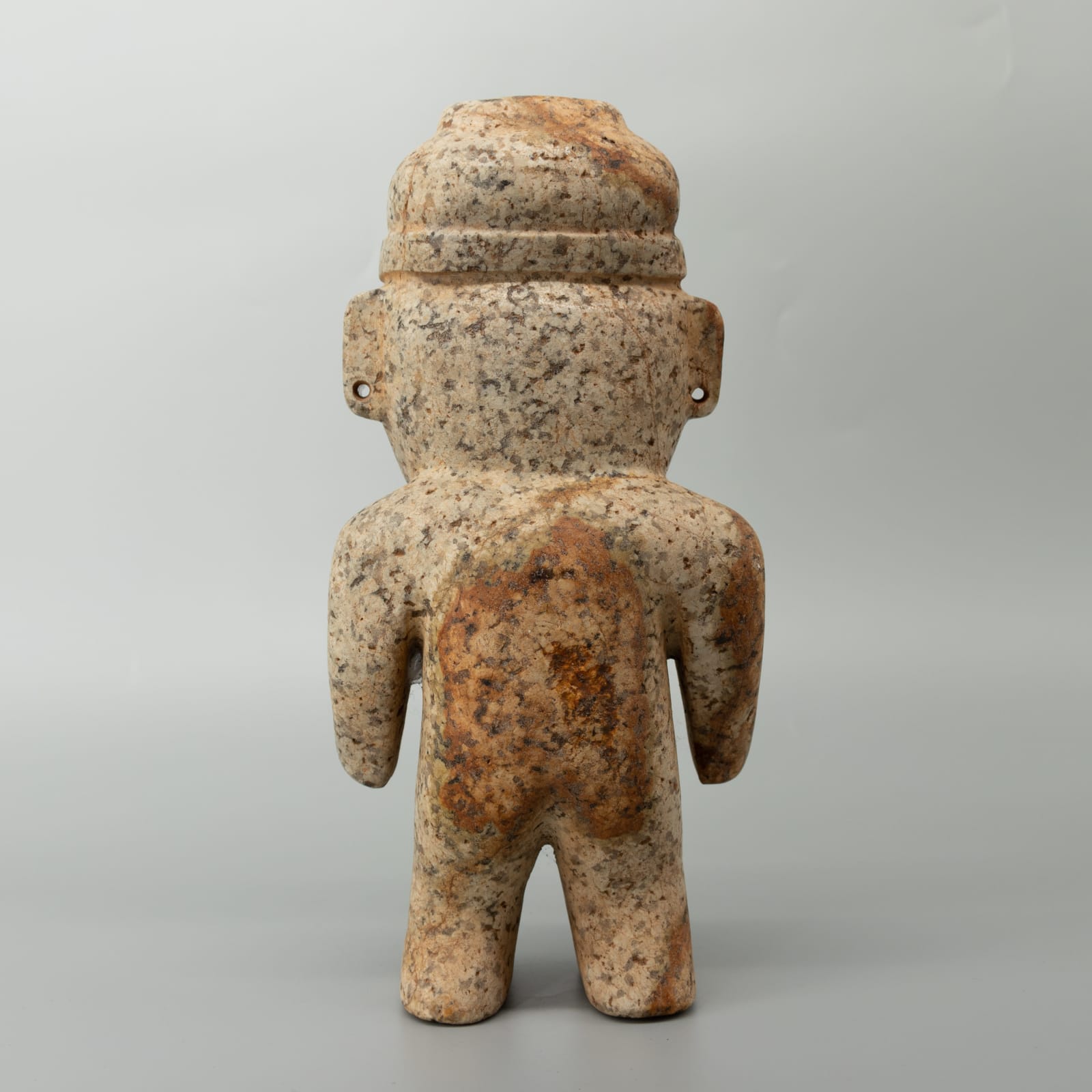Olmec Figure of a Werejaguar , c. 900 to 500 BCE
height 9 1/2 in
Further images
Polished to a shine, this beautiful sculpture epitomizes the art of the Olmec culture. Created out of a bright green stone, his expression is grimacing. The anatomy shows that the artist had a basic understanding, yet kept the figure simple. The right arm is over the chest holding a celt, a type of prehistoric tool shaped like an ax head, the left arm outstretched with the hand closed in a fist. The features on the face are carefully detailed yet the ears are gently molded onto the face. This sculpture portrays the features commonly referred to as the “were-jaguar.” This name is used to describe a characteristic countenance of Olmec art generally exhibiting the puffy, fat cheeks and jowls of a human baby with the slanted eyes and curved mouth of a jaguar. The jaguar is one of the most potent symbols in Mesoamerican art. Often associated with the ruling power of the king, the jaguar was the most sacred beast in the animal pantheon. The veneration of this beast permeates the art of the Olmec. In this case, the were-jaguar statuette probably reflects (or is connected to) the Olmec belief that, in the distant past, a union between a woman and a jaguar had produced an earlier race of were- jaguars of which the Olmecs believed to be the descendants. The figure is represented standing, with a ritual loincloth. Given the ritual clothing involved, it is more than possible that we might be looking at the figure of a priest or shaman.
The Olmecs are generally considered to be the ultimate ancestor of all subsequent Mesoamerican civilisations. Thriving between about 1200 and 400 BC, their base was the tropical lowlands of south central Mexico, an area characterised by swamps punctuated by low hill ridges and volcanoes. Here the Olmecs practiced advanced farming techniques and constructed many permanent settlements. Their influence, both cultural and political, extended far beyond their boundaries; the exotic nature of Olmec designs became synonymous with elite status in other (predominantly highland) groups, with evidence for exchange of artefacts in both directions. Other than their art (see below), they are credited with the foundations of writing systems (the loosely defined Epi-Olmec period, c. 500 BC), the first use of the zero – so instrumental in the Maya long count vigesimal calendrical system – and they also appear to have been the originators of the famous Mesoamerican ballgame so prevalent among later cultures in the region. The art form for which the Olmecs are best known, the monumental stone heads weighing up to forty tons, are generally believed to depict kingly leaders or possibly ancestors. Other symbols abound in their stylistic repertoire, including several presumably religious symbols such as the feathered serpent and the rain spirit, which persisted in subsequent and related cultures until the middle ages.
Comparatively little is known of their magico- religious world, although the clues that we have are tantalising. Technically, these include all non- secular items, of which there is a fascinating array. The best- known forms are jade and ceramic figures and celts that depict men, animals and fantastical beasts with both anthropomorphic and zoomorphic characteristics. Their size and general appearance suggests that they were domestically- or institutionally-based totems or divinities. The quality of production is astonishing, particularly if one considers the technology available, the early date of the pieces, and the dearth of earlier works upon which the Olmec sculptors could draw. Some pieces are highly stylised, while others demonstrate striking naturalism with deliberate expressionist interpretation of some facial features (notably up-turned mouths and slit eyes) that can be clearly seen in this sculpture.
Provenance
This remarkably preserved pre-Columbian figure depicts the Olmec culture’s ‘were-jaguar’ deity, shown here with a characteristic downturned open mouth, almond eyes, head band, and a cleft in his head. The Olmec were-jaguar was a popular theme in Olmec art, and these figures often varied greatly in style, depicting figures which were almost entirely feline to entirely human. The deity–a rain god–is a hybrid between a jaguar and human infant, and was previously thought to be the only deity the Olmec people worshipped. Some scholars have postulated that the were-jaguar may have represented genetic abnormalities, such as Down syndrome and spina bifida, which would have caused the characteristic cleft head, downturned and toothless mouth, and fleshy lips. Three-dimensional depictions of the were-jaguar often appeared in stonework, from small figurines to large statues and temple monuments. The Olmec civilisation was the first major Mesoamerican culture, whose mythology, symbolism, and art greatly influenced almost all later pre-Columbian cultures including the Aztecs and the Mayans. The Olmecs developed on the present-day Mexican southern Gulf Coast between 1500-400 BCE. Olmec art continues to be regarded as one of Mesoamerica’s most striking, especially the stonework sculptures usually rendered from jade, clay, basalt, or greenstone. (ES.7446 FA).











